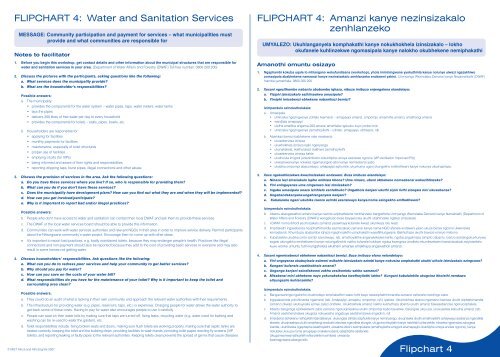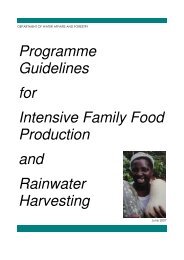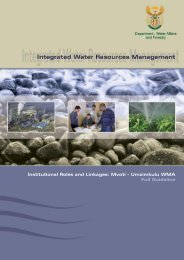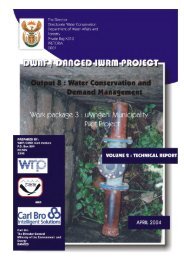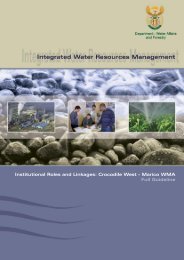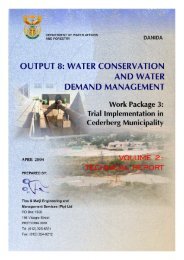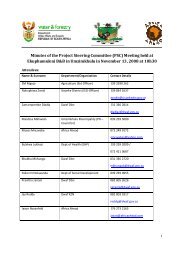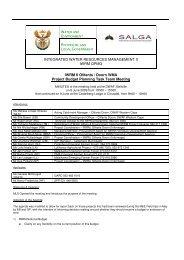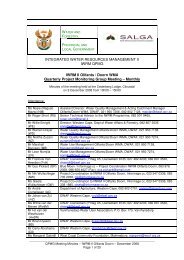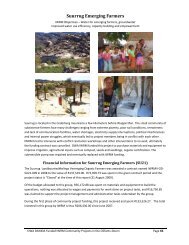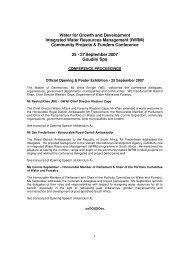You also want an ePaper? Increase the reach of your titles
YUMPU automatically turns print PDFs into web optimized ePapers that Google loves.
FLIPCHART 4: Water and Sanitation Services<br />
Message: Community participation and payment for services – what municipalities must<br />
provide and what communities are responsible for<br />
Notes to facilitator<br />
1. Before you begin this workshop, get contact details and other information about the municipal structures that are responsible for<br />
water and sanitation services in your area. (Department of Water Affairs and Forestry (DWAF) Toll free number: 0800 200 200)<br />
2. Discuss the pictures with the participants, asking questions like the following:<br />
a. What services does the municipality provide<br />
b. What are the householder’s responsibilities<br />
Possible answers:<br />
a. The municipality:<br />
• provides the components for the water system – water pipes, taps, water meters, water tanks<br />
• lays the pipes<br />
• delivers 200 litres of free water per day to every household<br />
• provides the components for toilets – stalls, pipes, bowls, etc.<br />
b. Householders are responsible for:<br />
• applying for facilities<br />
• monthly payments for facilities<br />
• maintenance, especially of toilet structures<br />
• proper use of facilities<br />
• emptying of pits (for VIPs)<br />
• being informed and aware of their rights and responsibilities<br />
• reporting dripping taps, burst pipes, illegal connections and other abuse.<br />
3. Discuss the provision of services in the area. Ask the following questions:<br />
a. Do you have these services where you live If so, who is responsible for providing them<br />
b. What can you do if you don’t have these services<br />
c. Does the municipality have development plans How can you find out what they are and when they will be implemented<br />
d. How can you get involved/participate<br />
e. Why is it important to report bad and/or illegal practices<br />
Possible answers:<br />
b. People who don’t have access to water and sanitation can contact their local DWAF and ask them to provide these services.<br />
c. The DWAF or the local water services board should be able to provide this information.<br />
d. Communities can work with water services authorities and relevant NGOs in their area in order to improve service delivery. Remind participants<br />
about the Nhlungwane community’s water project. Encourage them to come up with other ideas.<br />
e. It’s important to report bad practices, e.g. badly maintained toilets, because they may endanger people’s health. Practices like illegal<br />
connections and non-payment should also be reported because they add to the cost of providing basic services to everyone and may also<br />
result in some homes not getting water.<br />
4. Discuss householders’ responsibilities. Ask questions like the following:<br />
a. What can you do to redress poor services and help your community to get better services<br />
b. Why should you pay for water<br />
c. How can you save on the costs of your water bill<br />
d. What responsibilities do you have for the maintenance of your toilet Why is it important to keep the toilet and<br />
surrounding area clean<br />
Possible answers:<br />
a. They could do an audit of what is lacking in their own community and approach the relevant water authorities with their requirements.<br />
b. The infrastructure for providing water (e.g. pipes, reservoirs, taps, etc.) is expensive. Charging people for water allows the water authority to<br />
get back some of these costs. Having to pay for water also encourages people to use it carefully.<br />
c. People can save on their water bills by making sure that taps are turned off, fixing leaks, recycling water (e.g. water used for bathing and<br />
washing can be re-used to water the garden), etc.<br />
d. Toilet responsibilities include: fixing broken seats and doors, making sure flush toilets are working properly, making sure that septic tanks are<br />
treated correctly, keeping the toilet and the building clean, providing facilities to wash hands, providing toilet paper, erecting fly screens (VIP<br />
toilets), and reporting leaking or faulty pipes to the relevant authorities. Keeping toilets clean prevents the spread of germs that cause diseases.<br />
© MiET Africa and Africa!Ignite 2007<br />
FLIPCHART 4: Amanzi kanye nezinsizakalo<br />
zenhlanzeko<br />
Umyalezo: Ukuhlanganyela komphakathi kanye nokukhokhela izinsizakalo – lokho<br />
okufanele kuhlinzekwe ngomasipala kanye nalokho okubhekene nemiphakathi<br />
Amanothi omuntu osizayo<br />
1. Ngaphambi kokuba uqale lo mhlangano wokufundisana (workshop), yhola imininingwane yyokuthinta kanye nolunye ulwazi ngezakhiwo<br />
zomasipala ababhekene namaanzi kanye nezinsizakalo zenhlanzeko endaweni yakini. (Umnyango Wezindaba Zamanzi kanye Nezamahlathi (DWAF)<br />
Inamba yamahhala: 0800 200 200<br />
2. Xoxani ngezithombe nabantu ababambe iqhaza, nibuze imibuzo enjengalena elandelayo:<br />
a. Yiziphi izinsizakalo ezihlinzekwa umasipala<br />
b. Yimiphi imisebenzi ebhekene nabanikazi bemizi<br />
Izimpendulo ezinokutholakala:<br />
a. Umasipala:<br />
• uhlinzeka ngezingxenye zohlelo lwamanzi – amapayipi amanzi, ompompi, amamitha amanzi, amathangi amanzi<br />
• wendlala amapayipi<br />
• uletha amalitha angama-200 amanzi amahhala ngosuku kuyo yonke imizi<br />
• uhlinzeka ngezingxenye zamathoyilethi – izihlalo, amapayipi, obheseni, njll.<br />
b. Abanikazi bemizi babhekene nale misebenzi:<br />
• ukusebenzisa izinsiza<br />
• ukukhokhela izinsiza njalo ngenyanga<br />
• ukunakekela, ikakhulukazi izakhiwo zamathoyilethi<br />
• ukusebenzisa izinsiza kahle<br />
• ukuthulula imigodi (enezimbobo zokukhipha umoya ezenziwe ngcono (VIP-ventilation Improved Pit))<br />
• ukwaziswa kanye nokwazi ngamalungelo abo kanye nemisebenzi yabo<br />
• ukubika ompompi abaconsayo, amapayipi aqhumile, ukuxhuma ugesi okungekho emthethweni kanye nokunye ukuxhaphaza.<br />
3. Xoxa ngokuhlinzekwa kwezinsizakalo endaweni. Buza imibuzo elandelayo:<br />
a. Ninazo lezi zinsizakalo lapho enihlala khona Uma ninazo, ubani obhekene nomsebenzi wokuzihlinzeka<br />
b. Yini eningayenza uma ningenazo lezi zinsizakalo<br />
c. Ingabe umasipala unazo izinhlelo zentuthuko Ungathola kanjani ukuthi ziyini futhi zizoqala nini ukusebenza<br />
d. Ungabandakanyeka/ungahlanganyela kanjani<br />
e. Kubaluleke ngani ukubika izenzo ezimbi ezenziwayo kanye/noma ezingekho emthethweni<br />
Izimpendulo ezinokutholakala:<br />
b. Abantu abangawatholi amanzi kanye nezinto eziphathelene nenhlanzeko bangathinta Umnyango Wezindaba Zamanzi kanye Namahlathi (Department of<br />
Water Affairs and Forestry (DWAF)) wangakubo bese beyawucela ukuthi ubahlinzeke ngalezi zinsizakalo.<br />
c. I-DWAF noma ibhodi yezinsizakalo zamanzi yasekhaya kufanele ikwazi ukunikeza lolu lwazi.<br />
d. Imiphakathi ingasebenza neziphathimandla zezinsizakalo zamanzi kanye nama-NGO afanele endaweni yawo ukuze benze ngcono ukwenziwa<br />
komsebenzi. Khumbuza ababambe iqhaza ngephrojekthi yomphakathi waseNhlungwane. Bakhuthaze ukuthi baveze eminye imibono.<br />
e. Kubalulekile ukubika izinto ezimbi ezenziwayo, isb. amathoyilethe anganakekelwe kahle, ngoba angalimaza izimpilo zabantu. Izenzo ezinjengokuxhunywa<br />
kogesi okungekho emthethweni kanye nokungakhokhi nakho kufanele kubikwe ngoba kwengeza izindleko ekunikezelweni kwezinsizakalo eziyisisekelo<br />
kuwo wonke umuntu futhi kungaholela ekutheni amanye amakhaya angawatholi amanzi.<br />
4. Xoxani ngemisebenzi ebhekene nabanikazi bemizi. Buza imibuzo efana nelandelayo:<br />
a. Yini ongayenza ukubuyisela esimeni esikahle izinsizakalo ezimbi kanye nokusiza umphakathi ukuthi uthole izinsizakalo ezingcono<br />
b. Kungani kufanele uwakhokhele amanzi<br />
c. Ungonga kanjani ezindlekweni zakho zesikweletu sakho samanzi<br />
d. Misebenzi mini obhekene nayo yokunakekelwa kwethoyilethi lakho Kungani kubalulekile ukugcina itholethi nendawo<br />
elizungezile kuhlanzekile<br />
Izimpendulo ezinokutholakala:<br />
a. Bangacwaninga ngalokho okushodayo emphakathini wabo futhi baye naseziphathinimandla zamanzi ezifanele nezidingo zabo.<br />
b. Ingqalasizinda yokuhlinzeka ngamanzi (isb. Amapayipi, amapitsi, ompompi, njll.) iyabiza. Ukukhokhisa abantu ngamanzi kwenza ukuthi iziphathimandla<br />
zamanzi zikwazi ukubuyisela ezinye zalezi zindleko. Ukukhokhela amanzi nakho kukhuthaza abantu ukuthi amanzi bawasebenzise ngokucophelela.<br />
c. Abantu bangonga ezikweletwini zabo zamanzi ngokuqinisekisa ukuthi ompompi babo bavaliwe, balungise ukuvuza, ukuvuselela kabusha amanzi (isb.<br />
Amanzi asetshenziselwa ukugeza nokuwasha angabuye asetshenziswe engadini), njll.<br />
d. Imisebenzi ebhekene nethoyilethi ibandakanya: ukulungisa izihlalo eziphukile kanye neminyango, ukuqniseka ukuthi amathoyilethi ashaywayo asebenza ngendlela<br />
efanele, ukuqinisekisa ukuthi amathangi anobuthi elashwa ngendlela elungile, ukugcina ithoyilethi kanye nebhilidi kuhlanzekile, hlinzeka ngezinsiza zokugeza<br />
izandla, ukuhlinzeka ngephepha lasethoyilethi, ukwakha izikrini zezimpukane (emathoyilethe emigodi anamapayipi okukhipha umoya enziwe ngcono), kanye<br />
nokubika ukuvuza noma amapayipi onakele kubantu abaphethe abafanele.<br />
Ukugcinwa kwamathoyilethi ehlanzekile kuvimbela ukwanda<br />
kwamagciwane abanga izifo.<br />
<strong>Flipchart</strong> 4


